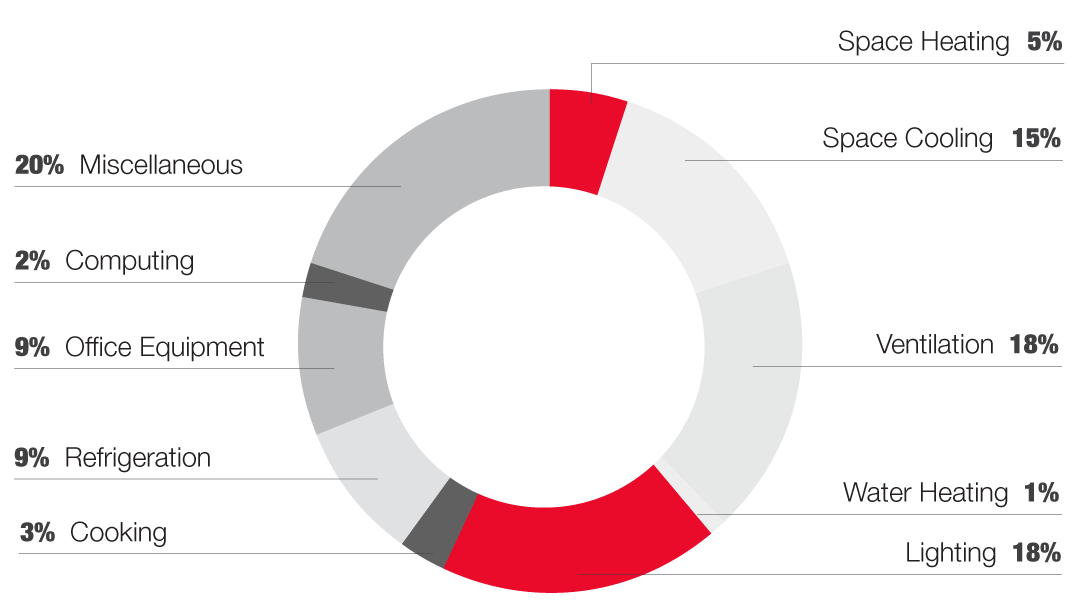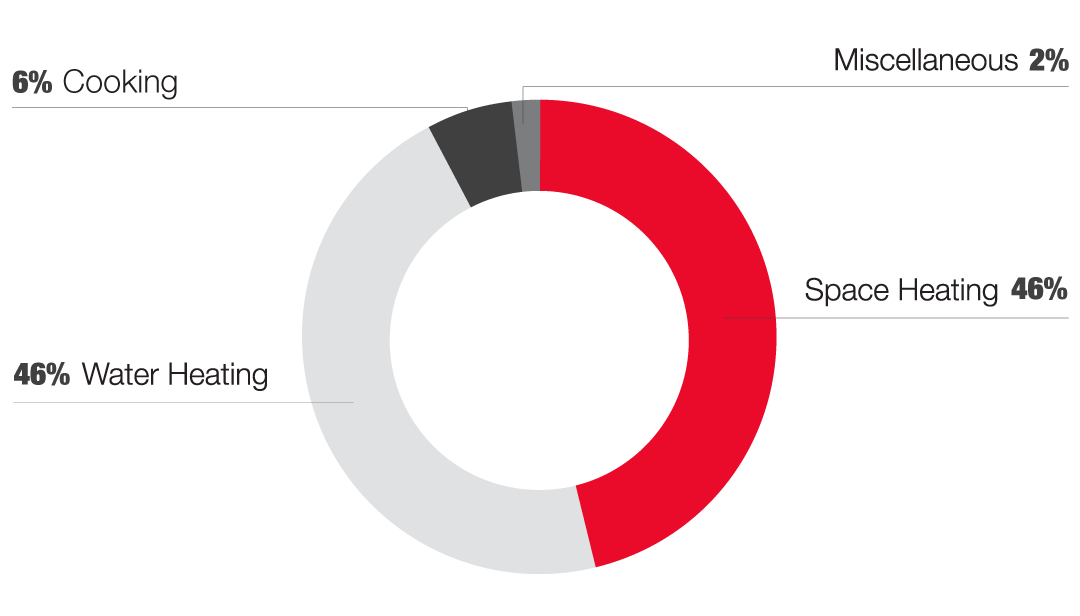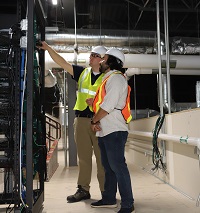Assist your long term care facility with energy savings
Did you know the average nursing home in the Midwest spends over $36,000 per year on electricity and natural gas? Bundling upgrades and saving on improvements is easier than ever with the Small Business Express program, which connects you with qualified contractors and rebates to create lasting energy efficiency savings for your assisted living facility or nursing home.
What uses the most energy in long term care facilities
The following pie charts illustrate what activities use the most energy and cost the most. Space heating, cooling and ventilation account for a large fraction of energy use in nursing homes. Electricity end uses include (from the top, counterclockwise): 20% miscellaneous, 2% computing, 9% office equipment, 9% refrigeration, 3% cooking, 18% lighting, 1% water heating, 18% ventilation, 15% space cooling and 5% space heating. Natural gas end uses include (from the top, counterclockwise): 6% cooking, 46% water heating, 46% space heating and 2% miscellaneous.
Electricity End Uses

Natural Gas End Uses

What's costing nursing homes the most
| End Uses | Average Electric Cost/Month | Average Gas Cost/Month | Energy Savings Potential |
|---|---|---|---|
| Space Heating, Cooling and Ventilation | $962 | $218 |
Moderate
|
| Miscellaneous | $506 | $9 |
Moderate
|
| Lighting | $456 | - |
High
|
| Office Equipment and Computing | $279 | - |
Moderate
|
| Water Heating | $25 | $218 |
Low
|
| Refrigeration | $228 | - |
High
|
Small Business Express is here to lend a hand
Small Business Express makes it easy for you to get professional guidance to identify energy-saving opportunities. Eligible rebates can help lower your out-of-pocket cost to replace failing equipment, and help you save energy and money long term.
Ways to Save

Heating and cooling equipment accounts for over one-third of energy used in nursing homes.
- Simple: Seal around windows and doors with new caulk and weather stripping every few years. Clean packaged terminal air conditioner (PTAC) heating and cooling coils at least once a month to ensure efficient operation. Encourage residents to keep blinds and curtains closed during the day during the summer. In the winter, keep blinds and curtains closed at night to keep warm air inside and residents comfortable.
- Low cost: Add insulation to energy code levels to maximize savings and comfort – be sure to add insulation after air sealing. Install programmable smart thermostats in each room to adjust temperatures when residents are away. Schedule regular tune-ups for air conditioners, furnaces and boilers to check that systems are working correctly. Replace filters regularly. Periodically, schedule a whole building tune-up to ensure efficient operation of the building.
- Capital investment: Replace older systems, such as air conditioners, furnaces and boilers, with high-efficiency models. Heating and cooling costs in resident rooms with PTAC units can also be reduced by installing packaged terminal heat pump (PTHP) units, which run more efficiently.

Miscellaneous
Miscellaneous energy usage typically costs over $500 a month and can be caused by energy use for washing and drying clothes, and outlet plug loads in resident rooms, such as televisions or computers.
Miscellaneous energy usage typically costs over $500 a month and can be caused by energy use for washing and drying clothes, and outlet plug loads in resident rooms, such as televisions or computers.
- Simple: Encourage residents to turn televisions and computers off when a room is not in use. Ensure clothes dryer lint traps are properly cleaned before drying clothes and only dry full loads of laundry.
- Low cost: Provide and install advanced power strips for residents, which detect a drop in energy usage and turn off electronics when the resident is not using them for an extended period of time.
- Capital investment: Upgrade to ENERGY STAR certified washing machines and dryers when replacing equipment.

Lighting typically costs $456 per month and is the third largest user of energy in nursing homes.
- Simple: Turn lights off when a space is not in use and encourage residents to do the same in their rooms.
- Low cost: Install occupancy sensors to turn lights off in areas where lights might be left on for extended periods, despite not being occupied.
- Capital investment: Replace fluorescent lights with LEDs to see savings of 50% or more! LEDs also have a longer life span resulting in reduced replacement costs. Replace exterior lights with LEDs to save even more.

There are several simple upgrades that can be implemented for energy savings related to computing and office equipment.
- Simple: Manage the computer network to ensure computers go into low-power or “sleep” mode after a period of inactivity. Turn off and unplug electronic equipment when not in use to prevent unnecessary power usage.
- Low cost: Install advanced power strips in offices, which detect a drop in energy usage and turn off electronics when staff have left for the day.
- Capital investment: Upgrade to ENERGY STAR certified models when replacing office electronics.

Water heating accounts for almost 50% of the typical nursing home’s natural gas usage.
- Simple: Lower your water heater temperature to 120°F; each 10°F reduction in water heater temperature can save 3-5% in water heating costs.
- Low cost: Install low flow showerheads that use 1.5-2.0 gallons of water per minute and faucet aerators that use 0.5-1.0 gallons of water a minute to reduce hot water usage.
- Capital investment: Replace older water heaters with high-efficiency models. Replace dishwashers with ENERGY STAR certified models.

A typical nursing home spends $228 month in refrigeration costs and the list of tips below could help reduce that cost.
- Simple: Check and replace seals around walk in coolers and freezers.
- Low cost: Service your refrigeration equipment every two years to ensure refrigeration levels have not decreased and the system is working properly.
- Capital investments: Upgrade to ENERGY STAR certified reach-in refrigerators and freezers.

See how your facility compares
Energy Use Intensity (EUI) is a common measure used to benchmark a building’s energy use as a factor of its size. To calculate EUI for your nursing home, total your electric bills for one year, then divide by your building’s square footage; repeat for natural gas. If the score is lower than those listed below, you are using less energy than most.
|
Average EUI for Nursing Homes in the Midwest
|
|
|---|---|
|
Electricity
|
Natural Gas
|
|
15.9 kWh/square foot
|
0.67 therms/square foot
|
Call us today at 800-432-8583 to learn about tools that can help you with benchmarking your facility.
Other Resources